Abstract
A strain of bacteria has been isolated which rapidly and efficiently utilizes the herbicide glyphosate (N-phosphonomethylglycine) as its sole phosphorus source in a synthetic medium. The strain (PG2982) was isolated by subculturing Pseudomonas aeruginosa ATCC 9027 in a synthetic broth medium containing glyphosate as the sole phosphorus source. Strain PG2982 differs from the culture of P. aeruginosa in that it is nonflagellated, does not produce pyocyanin, and has an absolute requirement for thiamine. Strain PG2982 has been tentatively identified as a Pseudomonas sp. strain by its biochemical activities and moles percent guanine plus cytosine. Measurements of glyphosate with an amino acid analyzer show that glyphosate rapidly disappears from the medium during exponential growth of strain PG2982. In batch culture at 30°C, this isolate completely utilized 1.0 mM glyphosate in 96 h and yielded a cell density equal to that obtained with 1.0 mM phosphate as the phosphorus source. However, a longer lag phase and greater generation time were noted in the glyphosate-containing medium. Strain PG2982 can efficiently utilize glyphosate as an alternate phosphorus source.
Full text
PDF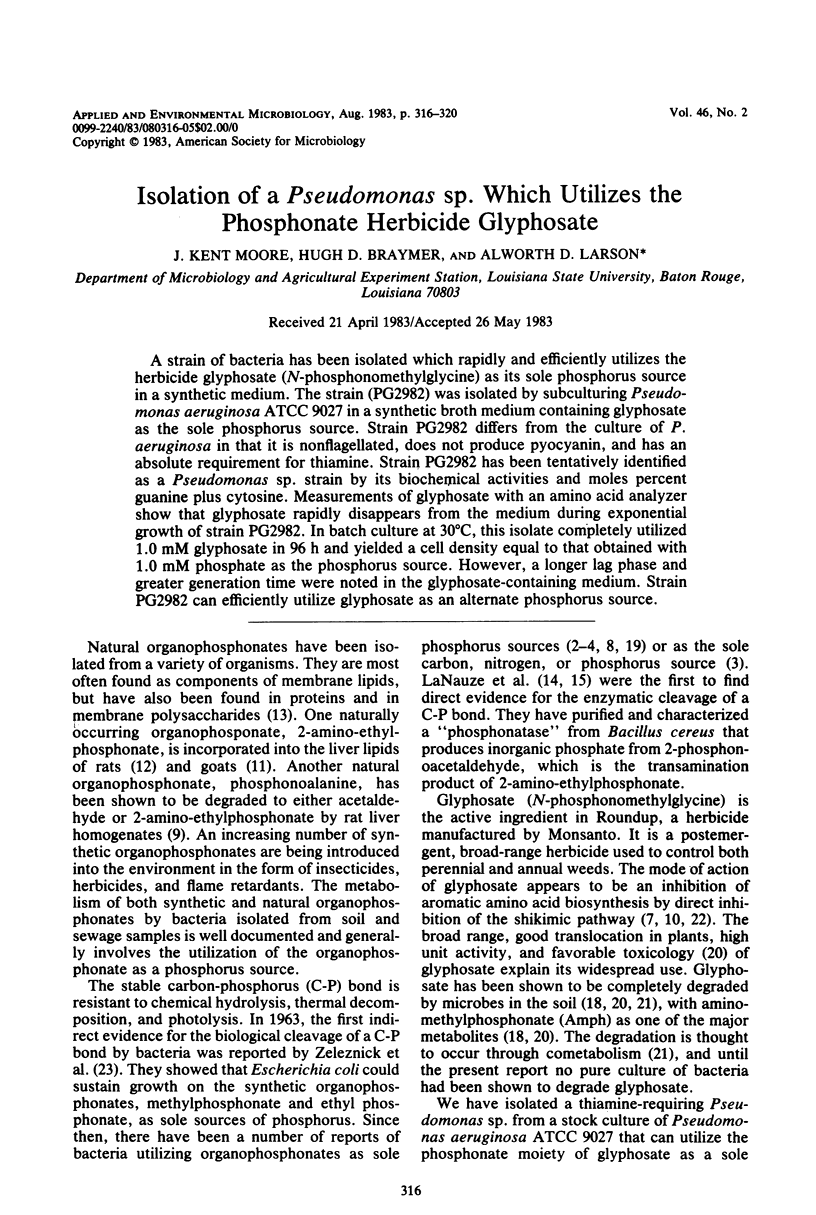
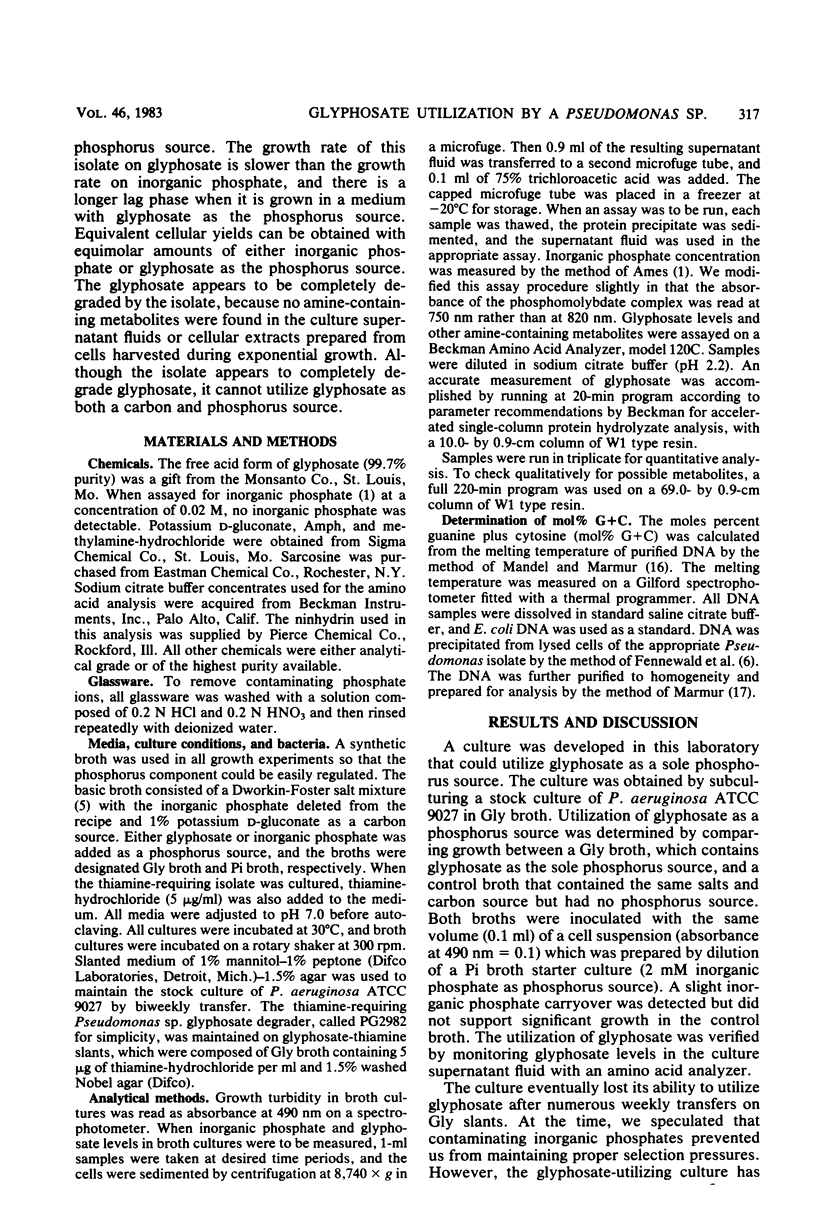
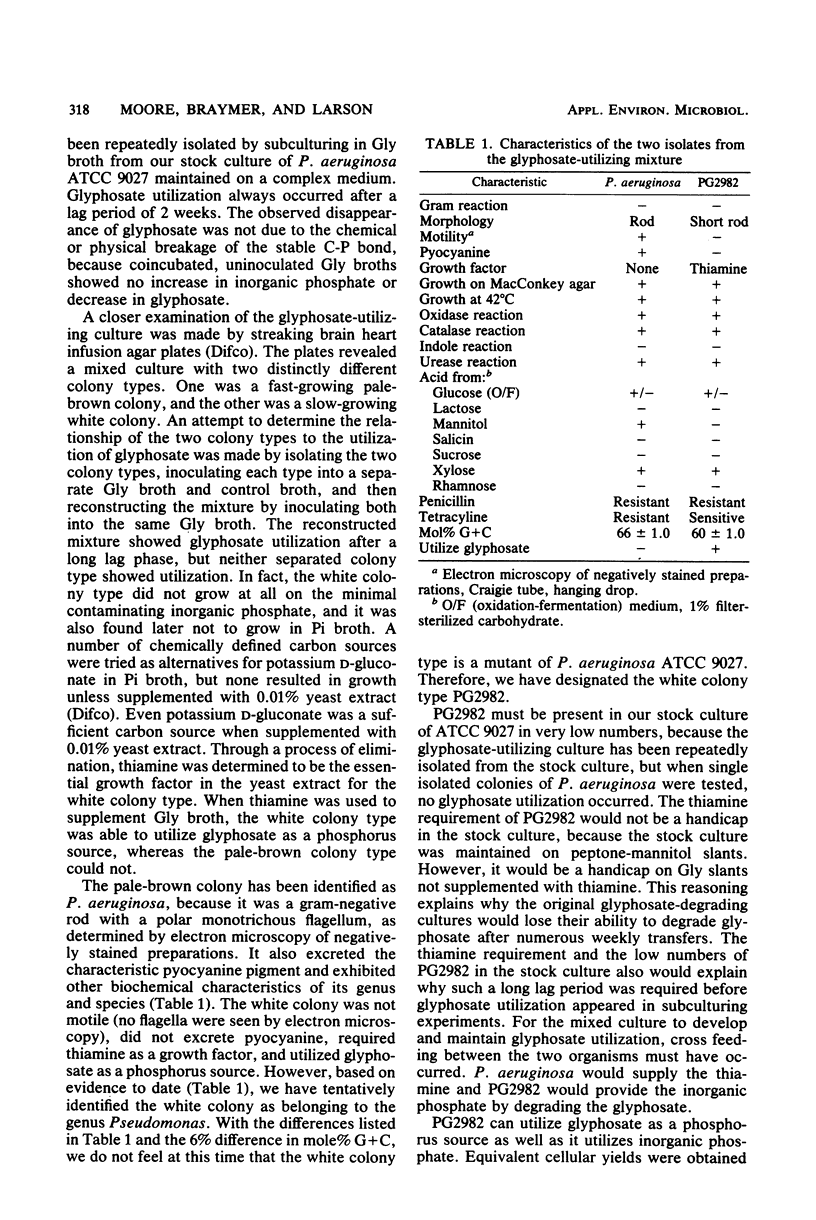
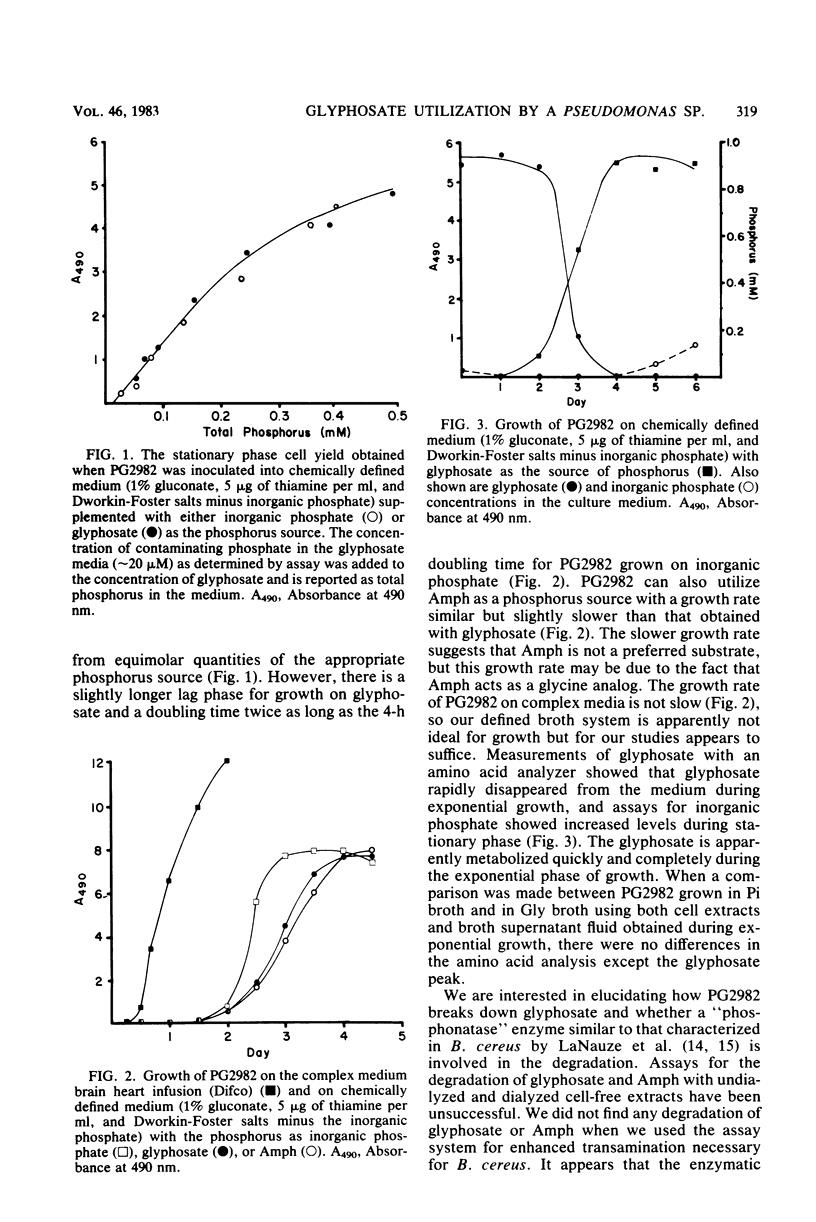
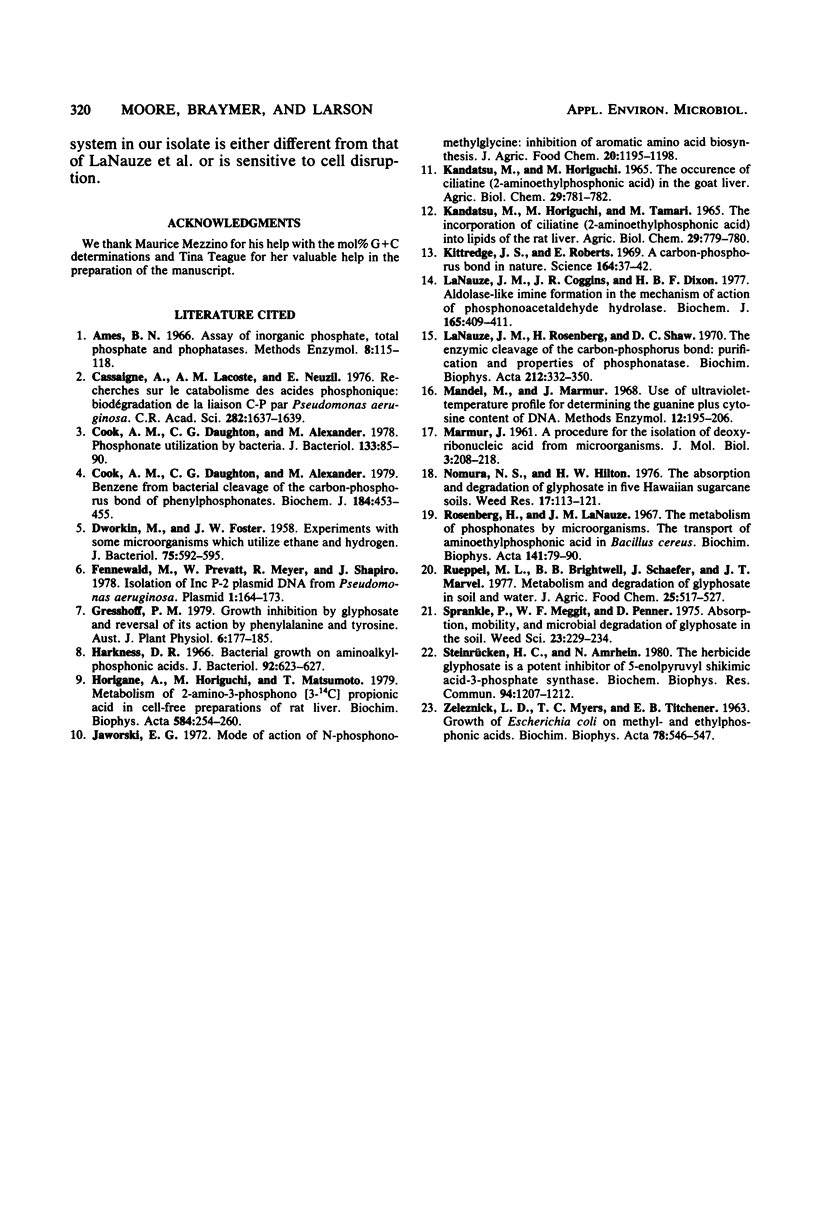
Selected References
These references are in PubMed. This may not be the complete list of references from this article.
- Cassaigne A., Lacoste A. M., Neuzil E. Recherches sur le catabolisme des acides phosphoniques: biodégradation de la liaison C--P par Pseudomonas aeruginosa. C R Acad Sci Hebd Seances Acad Sci D. 1976 May 3;282(17):1637–1639. [PubMed] [Google Scholar]
- Cook A. M., Daughton C. G., Alexander M. Benzene from bacterial cleavage of the carbon-phosphorus bond of phenylphosphonates. Biochem J. 1979 Nov 15;184(2):453–455. doi: 10.1042/bj1840453. [DOI] [PMC free article] [PubMed] [Google Scholar]
- Cook A. M., Daughton C. G., Alexander M. Phosphonate utilization by bacteria. J Bacteriol. 1978 Jan;133(1):85–90. doi: 10.1128/jb.133.1.85-90.1978. [DOI] [PMC free article] [PubMed] [Google Scholar]
- DWORKIN M., FOSTER J. W. Experiments with some microorganisms which utilize ethane and hydrogen. J Bacteriol. 1958 May;75(5):592–603. doi: 10.1128/jb.75.5.592-603.1958. [DOI] [PMC free article] [PubMed] [Google Scholar]
- Fennewald M., Prevatt W., Meyer R., Shapiro J. Isolation of inc P-2 plasmid DNA from Pseudomonas aeruginosa. Plasmid. 1978 Feb;1(2):164–173. doi: 10.1016/0147-619x(78)90036-7. [DOI] [PubMed] [Google Scholar]
- Harkness D. R. Bacterial growth on aminoalkylphosphonic acids. J Bacteriol. 1966 Sep;92(3):623–627. doi: 10.1128/jb.92.3.623-627.1966. [DOI] [PMC free article] [PubMed] [Google Scholar]
- Horigane A., Horiguchi M., Matsumoto T. Metabolism of 2-amino-3-phosphono[3-14C]propionic acid in cell-free preparations of rat liver. Biochim Biophys Acta. 1979 May 1;584(2):254–260. doi: 10.1016/0304-4165(79)90270-8. [DOI] [PubMed] [Google Scholar]
- Kittredge J. S., Roberts E. A carbon-phosphorus bond in nature. Science. 1969 Apr 4;164(3875):37–42. doi: 10.1126/science.164.3875.37. [DOI] [PubMed] [Google Scholar]
- La Nauze J. M., Coggins J. R., Dixon H. B. Aldolase-like imine formation in the mechanism of action of phosphonoacetaldehyde hydrolase. Biochem J. 1977 Aug 1;165(2):409–411. doi: 10.1042/bj1650409. [DOI] [PMC free article] [PubMed] [Google Scholar]
- La Nauze J. M., Rosenberg H., Shaw D. C. The enzymic cleavage of the carbon-phosphorus bond: purification and properties of phosphonatase. Biochim Biophys Acta. 1970 Aug 15;212(2):332–350. doi: 10.1016/0005-2744(70)90214-7. [DOI] [PubMed] [Google Scholar]
- Rosenberg H., La Nauze J. M. The metabolism of phosphonates by microorganisms. The transport of aminoethylphosphonic acid in Bacillus cereus. Biochim Biophys Acta. 1967 Jun 13;141(1):79–90. doi: 10.1016/0304-4165(67)90247-4. [DOI] [PubMed] [Google Scholar]
- Rueppel M. L., Brightwell B. B., Schaefer J., Marvel J. T. Metabolism and degradation of glyphosphate in soil and water. J Agric Food Chem. 1977 May-Jun;25(3):517–528. doi: 10.1021/jf60211a018. [DOI] [PubMed] [Google Scholar]
- Steinrücken H. C., Amrhein N. The herbicide glyphosate is a potent inhibitor of 5-enolpyruvyl-shikimic acid-3-phosphate synthase. Biochem Biophys Res Commun. 1980 Jun 30;94(4):1207–1212. doi: 10.1016/0006-291x(80)90547-1. [DOI] [PubMed] [Google Scholar]
- ZELEZNICK L. D., MYERS T. C., TITCHENER E. B. GROWTH OF ESCHERICHIA COLI ON METHYL- AND ETHYLPHOSPHONIC ACIDS. Biochim Biophys Acta. 1963 Nov 15;78:546–547. doi: 10.1016/0006-3002(63)90921-1. [DOI] [PubMed] [Google Scholar]


